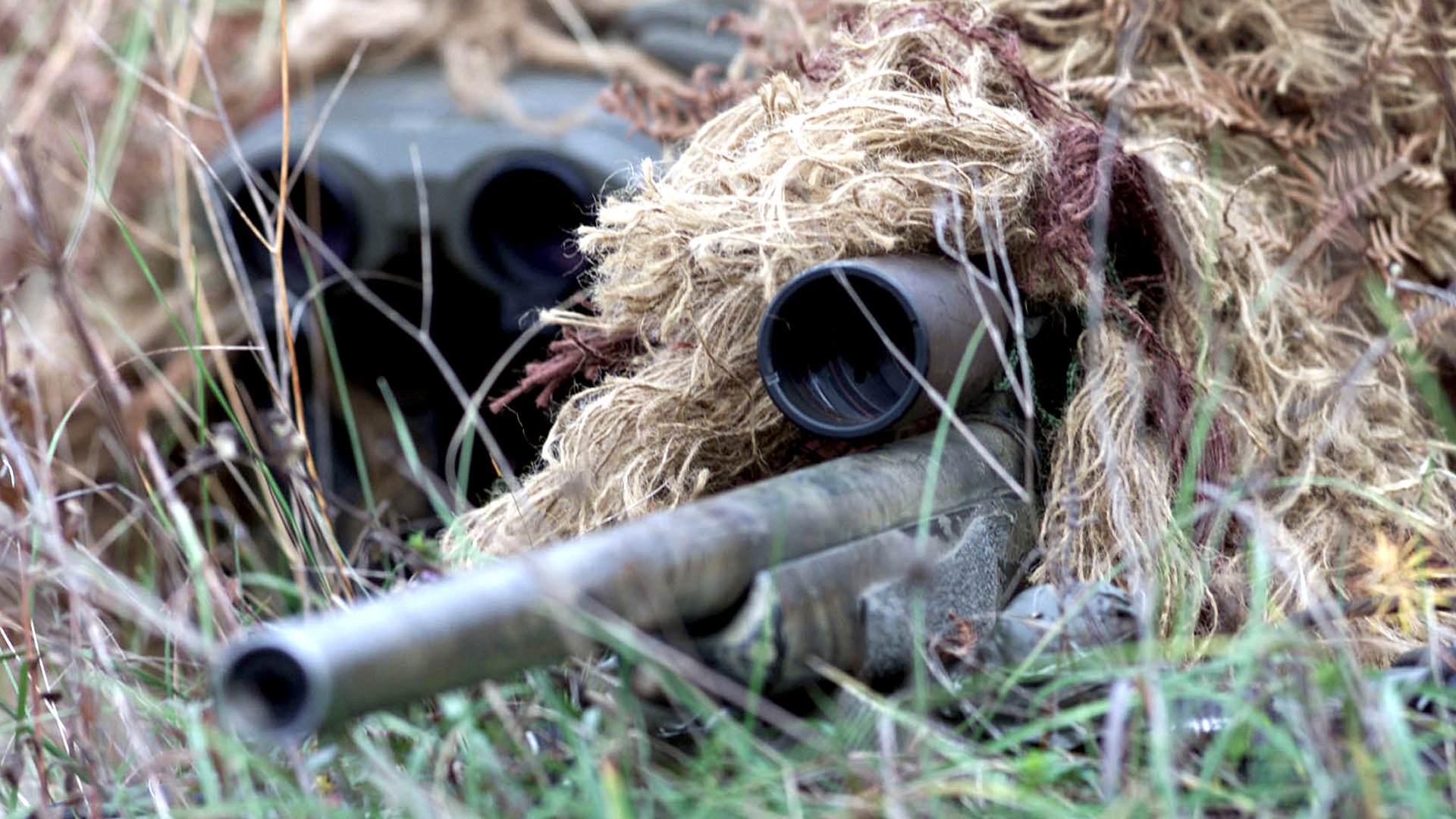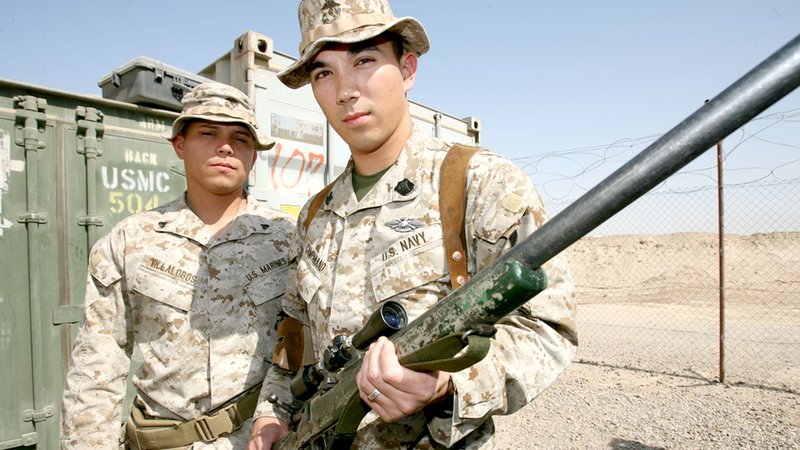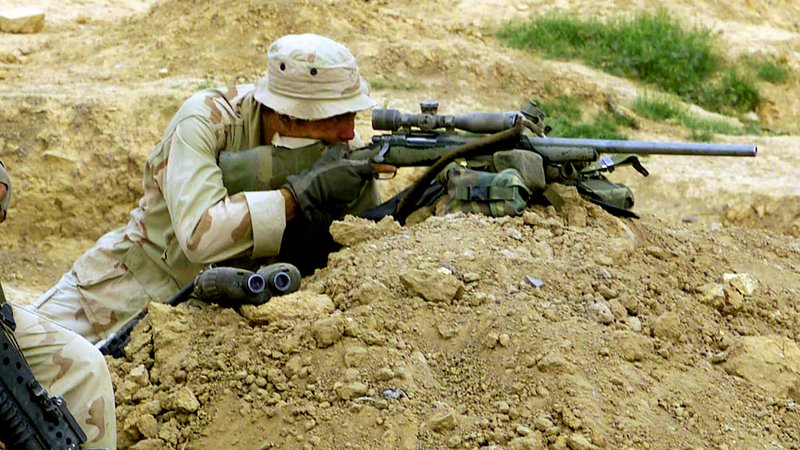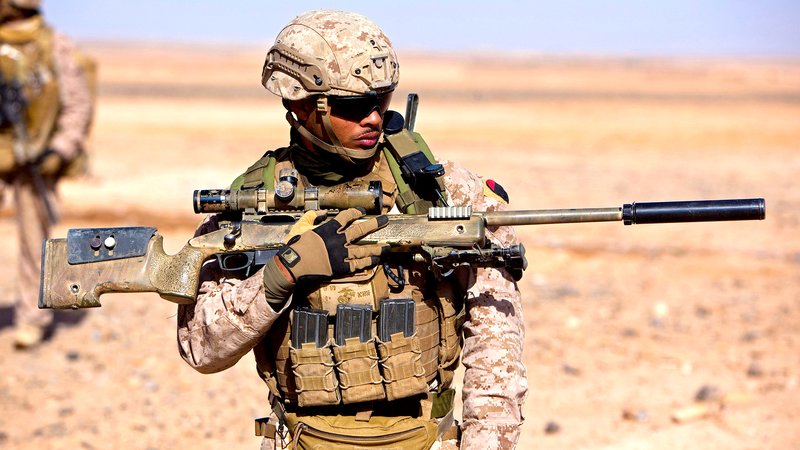Death From Afar: How the M40 Earned Its Place Among the Best Sniper Rifles

Marine Corps Sgt. Michael Sistunk and Lance Cpl. Matthew Bateman practice stalking techniques with an M-40 Sniper Rifle during Exercise Slunj 2000. Photo courtesy of Wikimedia Commons.
On June 16, 2006, in Habbaniyah, Iraq, a United States Marine Corps sniper team spotted an insurgent sitting inside a parked vehicle. He was armed with a long rifle. Nearby stood a second insurgent. The scout sniper took aim at the insurgent in the car. He relaxed, keeping the scope’s crosshairs on the man’s head. He applied slow, steady pressure on the trigger until the recoil of his M40 rifle surprised him. The shot killed the man where he sat. Then the spotter quickly shot the second insurgent three times in the chest.
The Marines, from Sniper Team Four of 3rd Battalion, 5th Marines, reported the two kills over the radio. A squad of grunts was dispatched to assess the damage.

A sniper with the 22nd Marine Expeditionary Unit's (Special Operations Capable)'s Maritime Special Purpose Force (MSPF) takes aim at a target with his his M40A1 sniper rifle during live-fire training on Udari Range outside Camp Beuhring, Kuwait, Dec. 11, 2005. Photo courtesy of Wikimedia Commons.
The grunts found the car and the two lifeless bodies. The man inside the vehicle was slumped over with the long rifle in his lap. The Marines immediately recognized it as an M40A1 — the same type of rifle used by the scout snipers who had killed him.
As it turned out, the insurgent’s M40 once belonged to a scout sniper from 2nd Battalion, 4th Marines, who had been killed two years earlier along with the rest of his team in Ramadi. Sniper Team Four returned the recovered rifle to 2/4, bringing some closure to the fallen Marine’s comrades.
Before the scout snipers killed him, the man with the M40 had terrorized Marines in Habbaniyah for two years. In fact, it was believed that he was directly responsible for the deaths of several Marines and Iraqi soldiers.

Navy Petty Officer 2nd Class Andrew J. Campanano (right) and Cpl. Angel S. Villalobos, both former Magnificent Bastards of 2nd Battalion, 4th Marine Regiment and now assigned to Regimental Combat Team 5, hold the M-40A1 sniper rifle recovered by Marines of 3rd Battalion, 5th Marine Regiment. Both Campanano and Villalobos were in Ramadi when a four-man sniper team was killed on a rooftop June 21, 2004. US Marine Corps photo by Gunnery Sgt. Mark Oliva.
Thus, even in untrained hands, the M40 proved to be deadly accurate. In the hands of Sniper Team Four, it was the bane of every insurgent who dared to raise his head within shooting distance of the Marines. Just like it had been the bane of America’s enemies in previous wars. Marine scout snipers have done most of their shooting on variants of the M40 for the last 56 years. Among many of those who have wielded it in combat, the beloved bolt-action rifle is considered effective to the point of being irreplaceable. Here’s why.
Related: What It Means To Be a Marine Corps Scout Sniper, According to 5 Scout Snipers
The Vietnam War and the First M40s
Since its founding, the Marine Corps has emphasized the importance of individual marksmanship. In no sect of the Marine Corps is it emphasized more than among scout snipers.
The first scout snipers saw action in World War II. Back then, the Corps did not have a standard sniper rifle. Shooters wielded a variety of weapons, depending on their individual preferences or simply whatever was available. The majority of them used M1903 Springfield rifles equipped with lengthy, 8-power Unertl scopes.
During the Korean War, scoped M1 Garands were added to the US arsenal and used by US forces, along with the M1903, for long-range shooting. After the war, the Marine Corps decided to invest more money and resources into developing professional marksmen and overhauled its scout sniper program.

During a firefight, a US Marine Corps scout sniper from Charlie Company, 1st Battalion, 5th Marines, 1st Marine Division out of Camp Pendleton, California returns enemy fire with an M40A1 sniper rifle from a protected position, in support of Operation Iraqi Freedom, April 8, 2003. Photo courtesy of Wikimedia Commons.
In 1961, a new, more challenging course for scout snipers was established in Hawaii. Then, in 1966, the newly trained scout snipers were issued the first standardized sniper rifle: the M40.
The M40 is a bolt-action Remington 700 tailored to the specific needs of Marine scout snipers. The first M40s derived from the Remington Model 40X — a heavy-barreled varmint version of the Model 700, chambered in 7.62x51mm, or simply .308.
Most Vietnam-era scout snipers, including Chuck Mawhinney and Eric England, used the early M40s to rack up high kill counts. Some, like Carlos Hathcock, used Winchester Model 70s chambered in the slightly larger-cased .30-06 Springfield.
Related: How PIGs Become HOGs — a Visual Journey in Marine Corps Scout Sniper Training
Evolution of the M40 Sniper Rifle
The M40 proved highly effective in the hands of trained shooters, but there was still room for improvement. For example, the rifle’s one-piece wooden stock tended to swell in the wet jungles and rice paddies of Vietnam. As the wood warped from moisture, the weapon became less accurate.
To fix this, Marine armorers updated the rifle with an all-fiberglass McMillan stock, giving birth to the first M40 variant: the A1. The M40A1 was also outfitted with a more powerful scope than its predecessor.

Cpl. Dennis Cox, a New York City native and scout sniper with 1st Battalion, 9th Marine Regiment, patrols with a section of Marines during an interdiction operation in Helmand province, Afghanistan, Dec. 19, 2013. Photo courtesy of Wikimedia Commons.
In 1999, the Marine Corps upgraded the M40 again, adding a more ergonomic stock, an improved scope, a detachable magazine, and the ability to attach bipods. The first M40A3s were fielded in 2001 and saw extensive use by Marines in both Operation Enduring Freedom and Operation Iraqi Freedom. Scout snipers who served in those conflicts got to know the weapon intimately.
“The M40 is a very personal weapon system,” said Jordan Laird, who served in Iraq and Afghanistan as a scout sniper with 3rd Battalion, 5th Marines. “Just imagine: You’re looking at a target then ride the bolt forward and lock it down. You come back to your hand grip, flick your safety off, and start squeezing the trigger while your spotter counts you down to take a life. It’s very, very personal.”
Related: Rise of the Deadeyes: How Marines Evolved From Infantrymen to Scout Snipers
The Last of Its Kind
Today, M40s are getting harder to come by. The M40A5, which replaced the A3 in 2009, is still used by the Marine Corps, though mostly for training purposes. Its barrel is shorter than the A3’s and threaded to accommodate a suppressor. The A5 also features an additional rail to fit a night vision optic.
In 2016, the Marine Corps fielded yet another version of the rifle: the M40A6. The A6 improved upon the A5’s design with a new, modular stock.

A U.S. Sailor with the Maritime Raid Force, 11th Marine Expeditionary Unit (MEU), sights in on an M40A6 sniper rifle during at live-fire sniper range at the King Abdullah II Special Operations Training Center. Photo courtesy of Wikimedia Commons.
Despite the M40’s consistent upgrades, other precision rifles, like the Mk11, Mk12, and Mk13 Mod7, are generally more favored by today’s top marksmen. And the Mk22 Mod 0 sniper system will replace both the M40A6 and the Mk13 Mod7 in the Marine Corps’ arsenal.
The Mk22 Mod 0 features replaceable barrels that allow shooters to change calibers depending on their mission.
Technologically superior though the Mk22 may be, the M40 earned its stripes on the battlefield. For that reason, it will always hold a special place in the hearts of those Marines who once carried it into combat.
“Unlike a semi-automatic rifle like the Mk11, where you just flick the safety off and start throwing rounds downrange, using the M40 is more methodical,” said Laird. “It’s kind of like how a monk ritually feels his prayer beads.”
Read Next: 10 Marines Just Became the 1st To Earn the Title ‘Recon Sniper’

Mac Caltrider is a senior staff writer for Coffee or Die Magazine. He served in the US Marine Corps and is a former police officer. Caltrider earned his bachelor’s degree in history and now reads anything he can get his hands on. He is also the creator of Pipes & Pages, a site intended to increase readership among enlisted troops. Caltrider spends most of his time reading, writing, and waging a one-man war against premature hair loss.
BRCC and Bad Moon Print Press team up for an exclusive, limited-edition T-shirt design!
BRCC partners with Team Room Design for an exclusive T-shirt release!
Thirty Seconds Out has partnered with BRCC for an exclusive shirt design invoking the God of Winter.
Lucas O'Hara of Grizzly Forge has teamed up with BRCC for a badass, exclusive Shirt Club T-shirt design featuring his most popular knife and tiomahawk.
Coffee or Die sits down with one of the graphic designers behind Black Rifle Coffee's signature look and vibe.
Biden will award the Medal of Honor to a Vietnam War Army helicopter pilot who risked his life to save a reconnaissance team from almost certain death.
Ever wonder how much Jack Mandaville would f*ck sh*t up if he went back in time? The American Revolution didn't even see him coming.
A nearly 200-year-old West Point time capsule that at first appeared to yield little more than dust contains hidden treasure, the US Military Academy said.












